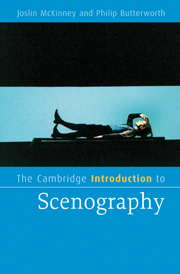Preface
Published online by Cambridge University Press: 05 February 2015
Summary
The aim of this book is to introduce the reader to the purpose, identity and scope of scenography and the theories and concepts which provide a critical framework within which it may be discussed. The work concentrates on scenographic developments in the twentieth century and considers how these continue to evolve in the twenty-first century. Scenographic principles are explained through practical examples and their theoretical context.
Although there are many instances which illuminate different ways in which design shapes the creation of scenography, the book is not exclusively concerned with the role of the theatre designer. In order to map out the wider territory and potential of scenography the work discusses the practice and theory of pioneering scenographers together with the work of directors, writers and visual artists.
Scenography is located as an emergent academic discipline through provision of a conceptual framework for consideration as performance practice and modes of communication with audiences.
The book is intended to be of principal value to university students, both undergraduate and postgraduate, who study theatre and performance. It provides conceptual tools to analyse and discuss scenographic aspects of these disciplines.
In Part 1, Elements, Chapter 1 discusses definitions of the term scenography and its relation to other aspects of the theatrical event. It identifies key elements in scenography. Chapter 2 extends understanding of these elements by discussing the practice and principles of key scenographic innovators in the twentieth century.
- Type
- Chapter
- Information
- The Cambridge Introduction to Scenography , pp. xiii - xivPublisher: Cambridge University PressPrint publication year: 2009

